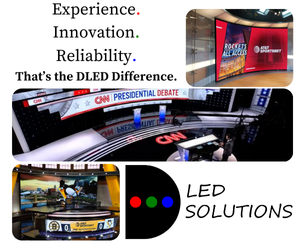AI takes practical turn at NAB Show as media companies focus on ROI

Subscribe to NewscastStudio for the latest news, project case studies and product announcements in broadcast technology, creative design and engineering delivered to your inbox.
Media technology companies are shifting their AI strategies from theoretical concepts to practical implementations that address specific industry challenges.
While AI dominated conversations at previous industry gatherings, the focus has evolved beyond abstract capabilities to concrete applications that deliver measurable benefits in workflow efficiency, content personalization and monetization opportunities.
“For AI to be valuable in media workflows, it needs to be tailored to specific use cases rather than being a one-size-fits-all solution,” said Philippe Petitpont of Moments Lab during an interview at the NAB Show 2025. “The mode between different players won’t really come from the quality of the model, but more from how well you know your customers.”
This industry-wide challenge of declining linear audiences, rising production costs and increasing fragmentation is driving the shift.
According to Devoncroft’s “Big Broadcast Survey,” 36% of respondents report AI as already impacting asset management and orchestration, with 44% seeing an impact on content production. Another 40% and 30%, respectively, expect impacts in those areas within the next one to two years.
Economic impact and operational value
“The biggest pain point most media companies have is how they need to change their products, their content, to work with the younger generation,” said Johan Bolin, chief research and innovation officer at Ateliere Creative Technologies. “If you can’t grow and maintain revenues, it doesn’t matter how low cost you have.”
The economic benefits of AI implementations are becoming clearer as early adopters report tangible returns.
Petitpont outlined three distinct value points that media companies are discovering:
“The first thing is AI to be able to do things in a way more efficient way. So like instead of having 10 people doing 100 videos, having five people doing 200, 300, 400 videos,” Petitpont explained. This efficiency translates to staffing changes, with companies “hiring traditional editors, betting on talent that are probably more expensive but more creative, that have autonomy.”
Beyond efficiency, the second value point involves enabling entirely new capabilities. “If you take the example of tariffs and I want to build a video about tariffs how it’s seen worldwide today… For a user, it’s very difficult to do that because you need to do a lot of research. You cannot be an expert on every topic. AI can be there to be able to have a holistic view,” said Petitpont.
The third point focuses on advanced analytics and prediction: “Being able to correlate audience data with my pool of content, fresh or old, and being able to quickly identify the meaning of my data… having the best videos that are working from my competitors or me and being able to take that as a reference and automatically create video from my archive.”
Early adopters are seeing these benefits translate into measurable results.
“We have a ratings prediction engine that outperforms human rates, and those are very sophisticated media people, efficiency-wise by 75%, accuracy-wise by 27%,” said Ivan Verbesselt, chief product and marketing officer for Mediagenix. “AI becomes very interesting if you want to discover your own catalog.”
Current implementations: From concept to production
While the potential benefits are clear, the path to implementation varies across organizations. Media companies are finding success by starting with focused applications that address specific workflow bottlenecks.
Chris McMahon, senior product marketing manager of Backlight, highlighted several practical applications already in production.
“We’ve had live text transcriptions for a while. But now we’re also introducing translation as well. So if you have a feed coming in, you can transcribe it in real time and also translate it in real time and then put that out to your different channels,” said McMahon.
For content adaptation, AI is simplifying previously labor-intensive processes.
“We’ve really deeply integrated auto-reframe into our product, so with a single clip, if you want to publish a 16:9 feed to 9:16, you don’t need to go through the whole rigmarole of editing it. You click one button and it will intelligently decide what’s the best way to frame this vertical,” McMahon explained.
At SDVI, Geoff Stedman, chief marketing officer, noted how customers like A&E Networks have taken a phased approach.
“A&E had this concept of in, during, and out. They focused on ‘in’ first, got that where they wanted it, made it really efficient. And then they worked on the ‘out.’ And then in the last year, they worked on the ‘during’,” said Stedman.
This approach has allowed them to gradually incorporate deeper processing at each stage of their content pipeline while maintaining operational continuity.
Implementation challenges and solutions
Despite the progress, significant hurdles remain in moving AI from proof of concept to enterprise-scale deployment.
Processing costs represent a major concern as capabilities expand.
“Models are evolving nearly every week for different reasons. Sometimes it’s to save costs. Sometimes it’s to improve the way the data is working,” said Petitpont, highlighting the ongoing balance between capability and affordability.
“We talk about the concept of a demo versus an in-use program. You can do a lot with AI. You can’t necessarily do it at scale and production,” said Kathleen Barrett, CEO of Backlight, emphasizing the gap between demonstrations and production-scale implementations. “We’re always orienting around what can we do at scale and production for our customers versus just throwing something up on a stream that’s not really at scale.”
Quality and accuracy issues persist, particularly in specialized detection tasks.
“We’ve got customers that run a show through an AI engine recognition to look for alcohol. Because they have to delete those scenes or weapons or cigarettes or shoulder nudity, like skin of the shoulder. Because different regions have different requirements for content,” said Stedman.
Integration with existing systems presents another major challenge.
Companies like SDVI are addressing this through orchestration platforms that connect multiple specialized applications rather than attempting to build monolithic solutions.
“The way we constructed the platform was to have a way of communicating with all these applications and orchestrating their behavior. And not only orchestrating and activating the applications but also provisioning the infrastructure that it needs to run on,” Stedman explained.
Supply chain transformation: From movement to manipulation
The concept of media supply chains is evolving from simply moving content through production pipelines to actively transforming content for different platforms and audiences — a shift that requires both technical and organizational changes.
“When you want to distribute on different platforms, it’s not only about subtitles,” noted Bolin. “If you want the content to work on TikTok or YouTube, you need to change the content more fundamentally.”
This transformation creates exponential complexity in versioning.
“The number of versions of content, localization, language changes, compliance edits — the amount of mechanical work that is done to content to create these packages that can go to 600 destinations. That’s a lot of touches of content,” said Stedman.
For news organizations, AI adoption faces a particular challenge in adapting to story-centric workflows.
“One of the things that the WolfTech acquisition has brought is that they have this concept of publishing points… They have some quite interesting AI services where I could gather a bunch of information about a story and then say ‘I want to use a smart publication point for this and I want you to summarize it for me or create a Facebook post,'” said Craig Wilson, product evangelist for video and media at Avid.
The human factor remains critical in these implementations.
“You can utilize AI technology to speed up that process,” said Wilson, noting the journalist is still fundamentally in control of the key steps in the process.
“That gets you to the next stage where a real person is actually going in and asking if that fits with the style and timbre of what story I want to tell,” Wilson noted, highlighting how AI assists rather than replaces editorial judgment.
Personalization and dynamic content on the horizon
As initial AI implementations mature, industry leaders are looking toward more sophisticated applications that could fundamentally change how content is created and distributed.
“I think content personalization is coming up a lot in the world of AI,” said Barrett. “We’re seeing high-level participation, leveraging something iconic as the work, and the metadata storage, and then facilitating on-the-fly production at scale, leveraging the metadata that’s sitting in the system.”
Barrett noted the term has different meanings across the industry: “Everyone has a different version of what it really means.”
For some, personalization begins with contextually aware advertising.
“We’re seeing customers come to us and look for ways to slightly modify the content or describe the content better so they can do better advertising,” explained Stedman, pointing to HBO’s work adapting content created without commercial breaks for ad-supported streaming.
Others envision more fundamental content adaptation.
“We run AI on content to do scene detection and scene descriptions, and it is those scene descriptions that will later help us to create more dynamic content. AI is kind of a tool that makes this possible at scale,” said Bolin.
Media executives considering AI investments emphasize the importance of starting with clear business problems rather than chasing technology.
Models are quickly becoming commodities, with the real difference being how well a tool understands the industry and, ultimately, a broadcaster’s customers.
Those implementing AI should consider how it will work at scale and how it will improve efficiency in the entire supply chain.
Across implementations, interoperability and ecosystem integration capabilities are proving more critical than the raw power of any single AI model, with the most successful deployments augmenting rather than replacing creative professionals.
As Joshua Stinehour of Devoncroft noted, the next 12 months will be pivotal for determining the next decade of broadcast with regards to AI and cloud decisions. For media companies navigating an increasingly fragmented landscape, these practical AI implementations represent not just technological advancement but essential business tools.
Subscribe to NewscastStudio for the latest news, project case studies and product announcements in broadcast technology, creative design and engineering delivered to your inbox.





tags
AI, Artificial Intelligence, Ateliere, Ateliere Creative Technologies, avid, Backlight, Chris McMahon, Craig Wilson, Geoff Stedman, Ivan Verbesselt, Johan Bolin, Kathleen Barrett, Mediagenix, Moments Lab, NAB Show 2025, NAB Show News, Philippe Petitpont, SDVI
categories
Broadcast Automation, Content Delivery and Storage, Heroes, Media Asset Management, NAB Show, Online and Digital Production